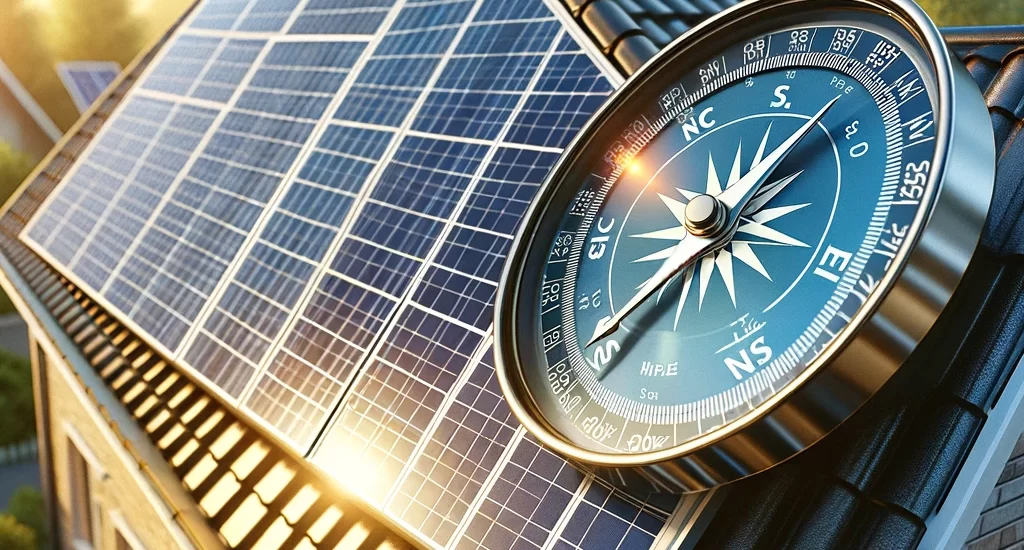Introduction: The Sun’s Path and Solar Efficiency – Why Orientation Matters
When diving into the world of solar energy, one of the foundational principles encountered is the significance of panel orientation—a detail that might appear minor yet substantially influences the efficiency and effectiveness of a solar power system. The widespread advice to orient solar panels southward is far from arbitrary; it is deeply anchored in optimising exposure to the sun’s rays for the utmost energy generation. This orientation is heralded as the gold standard in the Northern Hemisphere for a reason, directly impacting a solar panel system’s overall performance. In this exploration, we delve into the science and geography underlying south-facing solar panels, examining how this optimal placement can significantly boost your system’s energy output. Explore with us the rationale behind south-facing solar panels, how it leverages the sun’s trajectory to enhance system efficiency, and practical advice on achieving the greatest benefits from your solar setup.
Understanding Solar Panel Efficiency: The Basics
Solar panel efficiency is a measure of a panel’s ability to convert sunlight into usable electricity. At its core, efficiency depends on the quality of the photovoltaic (PV) cells within the panel and the amount of sunlight these cells can absorb. The optimal orientation of solar panels is crucial because it maximises the exposure of PV cells to direct sunlight throughout the day. South-facing panels, in the Northern Hemisphere, align perfectly with the sun’s path, ensuring that panels receive sunlight as directly as possible, especially during peak sunlight hours. This direct exposure is key to generating more electricity and, by extension, increasing the overall efficiency and output of a solar power system.
The Science Behind Solar Panel Orientation
The principle behind the south-facing recommendation lies in the path of the sun across the sky, which is inclined to move from east to west, with its highest point to the south in the Northern Hemisphere. By aligning solar panels to face south, they can capture the sun’s rays more directly for the longest possible duration each day. This orientation is particularly effective during winter months when the sun is lower in the sky. Adjusting the tilt of the panels to match the latitude of the location further optimises this alignment, enhancing the system’s ability to generate power even on shorter days.
Why South? Solar Path and Panel Placement Explained
South-facing panels capitalise on the sun’s trajectory, ensuring that solar systems produce energy as efficiently as possible. The angle of the sun’s path influences the intensity and duration of sunlight that panels receive. By orienting panels southwards, they remain perpendicular to the sun’s rays for the majority of the day in the Northern Hemisphere. This optimal positioning is critical for harnessing peak sunlight hours, significantly boosting the power output compared to panels facing other directions. It’s a strategy that combines geographic understanding with practical application to maximise renewable energy harvest from the available sunlight.
Measuring the Impact: South vs. Other Orientations
The tangible benefits of southward orientation can be measured in terms of increased energy production and efficiency gains. Studies and real-world data consistently show that south-facing solar panels outperform their east- or west-facing counterparts, often generating more power throughout the day. This difference in performance can translate into significant energy savings over time, highlighting the importance of correct panel orientation in the design of a solar energy system. While adjustments can be made for panels on roofs with varying orientations, the foundational preference for south-facing installation underscores the goal of optimising every aspect of solar energy capture.
Geographical Considerations for Solar Panel Orientation
Geography plays a pivotal role in determining the optimal orientation and tilt of solar panels. The specific latitude of an installation site directly influences the best angle for solar panels to maximise energy capture. In regions closer to the equator, solar panels may benefit from a lesser tilt, aligning more directly with the sun’s path. Conversely, locations at higher latitudes might require a steeper angle to effectively capture sunlight, especially during shorter winter days. Understanding local solar insolation – the amount of solar radiation received over a given area in a set time – is also crucial for optimising solar panel setups. Tailoring the panel orientation and tilt to match geographic and climatic conditions ensures that solar installations achieve their maximum potential output.
Adjustable Mounts: Adapting to the Sun’s Seasonal Shifts
The sun’s position in the sky changes with the seasons, affecting the amount of direct sunlight solar panels can capture. Adjustable mounts offer a solution by allowing the angle of solar panels to be modified in response to seasonal variations. This adaptability can significantly boost a solar system’s annual energy production. During summer months, a shallower angle takes advantage of the higher sun position, while a steeper angle in winter aligns the panels for optimal exposure when the sun is lower. Though requiring more effort or automation to adjust the panel angles, the energy output gains from using adjustable mounts can make this a worthwhile investment for maximising solar efficiency.
Technological Enhancements in Solar Tracking
Solar tracking systems represent a technological leap in optimising solar energy collection. These systems dynamically adjust the orientation of solar panels throughout the day to follow the sun’s path across the sky, ensuring that panels maintain the best possible angle to capture maximum sunlight. There are two main types of solar trackers: single-axis, which move east to west, and dual-axis, which also adjust for the sun’s elevation changes. While solar trackers involve higher initial costs and maintenance, their ability to increase energy production—often by 20% to 40% compared to fixed systems—can justify the investment, especially in large-scale or commercial solar applications.
Maximising Energy Independence: The Role of Solar Orientation
Understanding the importance of solar panel orientation is crucial for anyone looking to harness solar energy effectively. Positioning solar panels to face south maximises their exposure to sunlight, which is essential for generating more electricity throughout the day. This practice can lead to significant increases in energy production, helping homeowners and businesses not just to lower their energy bills but also to contribute more actively to a sustainable environment. Proper orientation enhances the efficiency of solar systems, making solar energy a more viable and cost-effective solution. This approach to solar installation underlines the broader goal of achieving energy independence, reducing reliance on non-renewable energy sources, and making a positive impact on the environment.
Optimising Solar Gain: Tips for Homeowners
For homeowners keen on maximising their solar panel efficiency, understanding the right installation and orientation is key. This means considering the direction and tilt of your panels to ensure they get the most sunlight year-round. It’s about more than just energy; it’s about integrating your solar setup seamlessly with your home’s design, ensuring both efficiency and aesthetics are balanced. Simple steps like assessing your site’s sun exposure, choosing compatible solar technology, and thoughtful placement can significantly enhance your solar gain, making your move to solar energy both practical and visually appealing.
Local Regulations and Solar Orientation Guidelines
When setting up solar panels, it’s crucial to be aware of local regulations, which can include zoning laws, building codes, and rules set by homeowners associations (HOAs). This aspect of solar installation involves understanding restrictions on system size, where you can place your panels, and how they should look to comply with local standards. To ensure a hassle-free installation and optimise your solar panel system’s performance, familiarising yourself with these regulations, the permit process, and available solar incentives can be incredibly beneficial. Engaging proactively with local authorities and navigating the regulatory landscape effectively can pave the way for successful solar adoption.
Designing for Efficiency: Solar Arrays and Building Integration
Starting from the ground up with solar energy in mind can transform both the efficiency and look of your property. This approach involves considering solar power early in the architectural process, aligning the structure’s design to optimise solar panel placement and performance. By integrating innovative technologies like building-integrated photovoltaics (BIPV), which blend into the building’s façade, architects can achieve a seamless merger of functionality and style. Highlighting successful projects, this discussion aims to inspire and inform on how to embed solar solutions in new constructions or renovations elegantly.
The Role of Shade and Environmental Factors
Shading from nearby objects can drastically reduce solar panel efficiency. It’s vital to perform a detailed shade analysis to pinpoint any obstacles that might block sunlight from reaching your panels. To minimise shading impacts, consider trimming trees, adjusting panel placement, or using technology like micro-inverters. Environmental elements like dust and bird droppings also affect efficiency, underlining the importance of regular maintenance. Properly managing these factors ensures your solar system operates at its best, maximising energy production and system longevity.
Beyond Orientation: Other Factors Influencing Solar Panel Performance
Beyond just facing the right direction, solar panel performance is influenced by several critical factors. These include the efficiency of the photovoltaic cells themselves, the necessity of routine maintenance for debris removal, and how temperature variations can affect efficiency. Additionally, incorporating energy storage solutions allows for the capture and use of surplus energy, showcasing how a comprehensive approach to solar energy management can substantially boost the efficiency and output of your solar energy system.
Future Innovations in Solar Panel Design and Orientation
The solar technology landscape is ever-evolving, with ongoing research and innovation pushing the boundaries of what’s possible. Exciting advancements, like bifacial solar panels that harness sunlight from both sides, and the development of new materials such as perovskites, are setting the stage for significant efficiency improvements and versatility in solar solutions. Moreover, the exploration of automated tracking systems that can dynamically adjust panels to the sun’s movement points to a future where solar energy capture is optimised through smart, responsive design.
Conclusion: Illuminating the Path with Solar Green Solutions
As we’ve explored the intricacies of solar panel orientation and the myriad factors contributing to optimal solar energy production, it’s clear that the journey to harnessing the sun’s power is both complex and rewarding. Solar Green Solutions stands at the forefront of this journey, offering expertise and innovative solutions to guide homeowners and businesses alike towards maximising their solar potential. For those ready to take the next step or seeking further insights into making solar energy work for them, AI Leia is available on our website to answer questions and connect you with the knowledge and resources you need. Together, we’re not just capturing sunlight; we’re illuminating the path to a sustainable, energy-efficient future.





